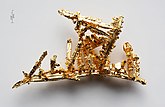Gold
 From RationalWiki - Reading time: 3 min
From RationalWiki - Reading time: 3 min
| It matters Chemistry |
| Action and reaction |
| Elementary! |
| Spooky scary chemicals |
| Er, who's got the pox? |
“”GOLD, n. A yellow metal greatly prized for its convenience in the various kinds of robbery known as trade. The word was formerly spelled "God"—the l was inserted to distinguish it from the name of another and inferior deity.
|
| —Ambrose Bierce, The Devil's Dictionary[1] |
Gold is a chemical element (symbol Au (from Latin aurum), atomic number 79). It is not chemically reactive, and is found in elemental form as nuggets or grains in rocks and rivers that eroded them. Its apparent indestructibility, brightness, and color have made it very desirable throughout recorded history. It was used as a basis for currency for a really long time. Due to its high malleability, ductility, resistance to corrosion, and electrical conductivity, it also has multiple industrial, medical, and culinary![]() applications. The world consumption of new gold produced is estimated to be about 50% in jewelry, 40% in investments, and 10% in industry.[2]
applications. The world consumption of new gold produced is estimated to be about 50% in jewelry, 40% in investments, and 10% in industry.[2]
Food additive[edit]
Gold is occasionally used as a food additive, with the E number E175, and is also known as aurum and "Pigment metal 3". There is a lack of evidence as to its safety or danger in food. As a food additive, it is mainly used for decoration, either as gold leaf or in small particles as powder. There is no firm evidence on the safety of eating gold, but because of its low solubility, it is unlikely to have much effect on the human body (except in a few people who exhibit an intolerance to gold). Gold nanoparticles can be absorbed by the body, and if absorbed, it can be found in serum, breast milk, and urine, but particles used in food are normally large enough to minimise risk of absorption.[3]
As medicine[edit]
Compounds of gold, particularly gold (I), have been used in medicine, including to treat tuberculosis and arthritis.[3] Preparations such as Auranofin![]() and gold thiolates are used to treat rheumatoid arthritis.
and gold thiolates are used to treat rheumatoid arthritis.
Alternative medicine[edit]
Gold in collodial or monatomic formulation is sometimes sold as an alternative medicine. According to the website Monatomic Orme, "Monatomic Gold is a powerful electrical conductor that has been known to help with physical and mental energy."[4] However, energy in the body is not transported as electricity but in chemical form. So it really isn't clear how it could work.
In economics[edit]
As a currency[edit]
Historically, most currency was backed by a country's gold reserves. Today, however, there is so much money in paper currency that there's not enough gold in the world for it all. Despite this, some nutty libertarians want to return to the gold standard.
As a scam[edit]
Watch Fox News for any period of time and you will see a commercial trying to get elderly people to invest in gold. First of all, these scams don't give you any gold; all you get is a certificate saying that you own the gold.[5] Some people try to sell gold under the guise that it has a very stable value when in fact its value is subject to fluctuations just like anything else.[6] Many of these scams overlap with survivalist woo, as they claim that a paper currency is only valuable because of a government, while gold has inherent value and thus would be the best currency in an apocalypse. In reality, while gold has some useful scientific and industrial applications, it has little everyday use and is only valued because people consider it rare, and things like oil and bullets would likely be more valuable in the event of societal breakdown.[7] Despite this, gold scammers make millions of dollars a year from gullible people.[8]
See also[edit]
| For those of you in the mood, RationalWiki has a fun article about Gold. |
References[edit]
- ↑ G, The Devil's Dictionary
- ↑ https://onrcoins.com/precious-metals/gold/ Archived at: https://web.archive.org/web/20161104190338/https://onrcoins.com/precious-metals/gold/
- ↑ 3.0 3.1 Scientific Opinion on the re-evaluation of gold (E 175) as a food additive, European Food Safety Authority, EFSA Journal 2016;14(1):4362, Wiley
- ↑ Monatomic Gold, Monatomic Orme, accessed 7 Jan 2019
- ↑ Older Americans Lose Millions Through Coin Scams, Doug Shadel and Joe Eaton, AARP 29 July 2016
- ↑ Gold Prices - 100 Year Historical Chart, Macrotrends
- ↑ Why Gold Would Be Useless in an Economic Apocalypse, Jordan Weissman, The Atlantic 23 December 2013
- ↑ As gold prices gather momentum, scammers are looking to capitalize, Elliot Smith, CNBC 6 March 2020
 KSF
KSF